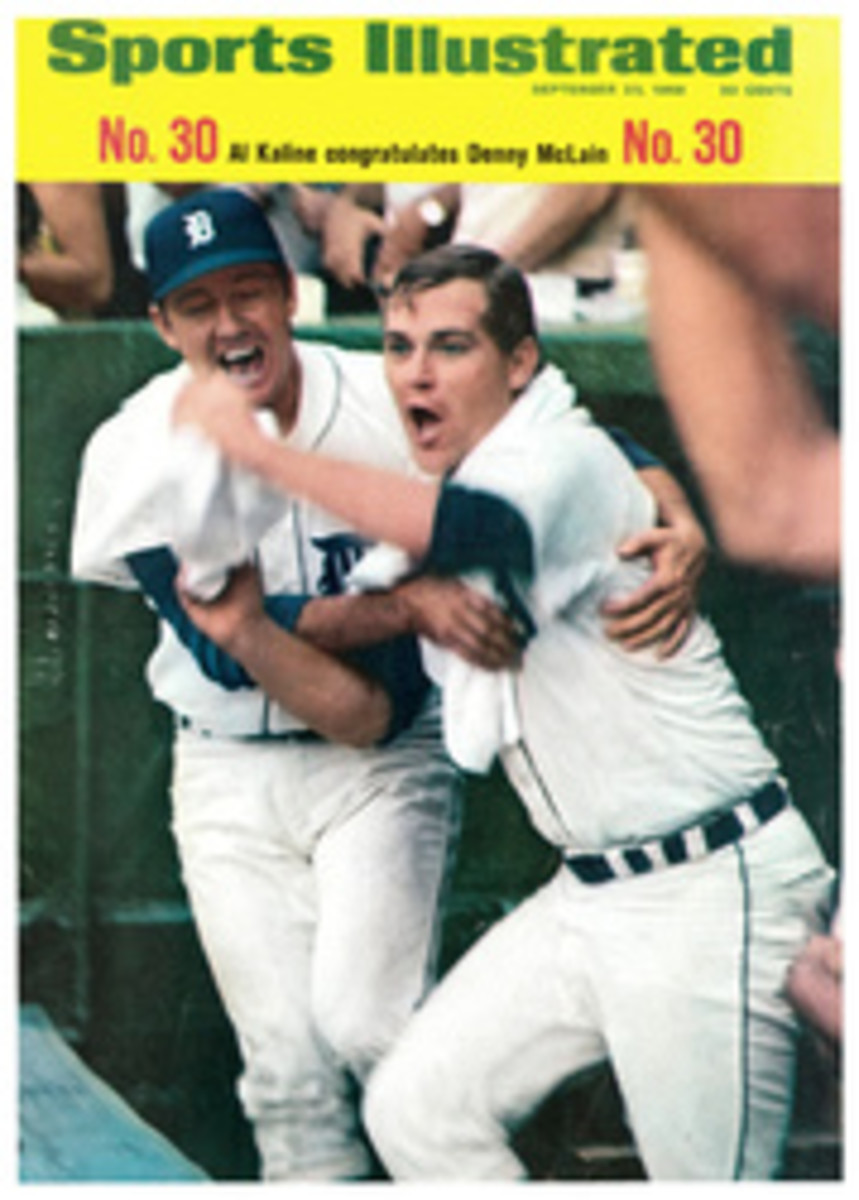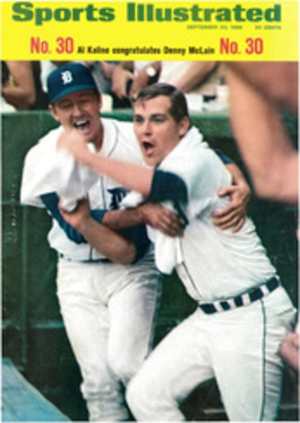
TRIUMPH AND TRAGEDY AT TAHOE
As Avery Brundage himself said two years ago when he went to check the pulse of the Little Olympic Games at Mexico City, "Well, I have seen the runners run at high altitude, and no one fell down dead."
American runners—and jumpers and throwers—last week concluded six weeks of sucking thin air on a pine-flecked granite mountaintop overlooking the casinos of Lake Tahoe, hard by the ragged eastern edge of California. Echo Summit is the same elevation as Mexico City, and it is at least as breathtaking. The Americans ran and ran, and they did not die. Over the last eight days, in the Absolutely Final Olympic Trials, following a daily schedule of heats and semifinals and finals patterned after the Games themselves, they proved the equal of any track and field team the United States has ever put together—at any altitude. It is certainly a faster team (if you make allowances for altitude-influenced times) and probably a stronger one; there is a growing confidence among the 67 members of it that they can handle a big bag of thin air like Mexico City any old time.
Death, in the case of selecting an Olympic team, is a relative noun, of course. There were some fine athletes at Echo Summit who died a little. Thirty-year-old Bob Schul, who had won a gold medal in Tokyo in 1964, went into the woods and cried after he failed to make the first three in the 5,000 meters. He was a painful sight coming down the stretch a distant last, his face contorted, his asthmatic wheezes audible even up in the stands, his once powerful stride a stagger as he fought age, altitude and the stiff, chilling winds that whipped the track. He did not quit, but he never had a chance.
Little Gerry Lindgren, an Olympian in 1964 at 18, flopped down on the infield after his second failure (he missed in both the 10,000 and 5,000) and lay there, spread-eagled, his eyes closed and mouth ajar, paying no mind to the stone under his back. Steeplechaser Pat Traynor and his wife sat with their arms tight around one another for a long time, sobbing. A pretty girl came up to Decathloner Russ Hodge, sitting in the stands a few days after injury had done him in, and asked why he had not called her. "Well," said Hodge, not smiling, "I haven't felt much like calling anybody." Richmond Flowers, fighting his way back all summer from a disabling thigh injury, was stunned by his failure in the high hurdles, and so was Dave Patrick by his in the 1,500. But Billy Mills, the winner of the 10,000 at Tokyo, anticipated disaster and had prepared an answer for the inevitable question. "Tomorrow," said Mills, "is the first day of the rest of my life."
The quality of those who did not make it is, of course, an indication of the quality of those who did. They were good enough in those eight days to break four world records: Geoff Vanderstock in the 400-meter hurdles; John Carlos at 200 meters; Lee Evans at 400; Bob Seagren in the pole vault. Predictably, they did not do better in running events of 800 meters and over, where blood counts and cell viscosities and single carburetors can cause a man grief at high altitude. It was predictable, too, that with less air resistance there would be improvements in most field events and the shorter races.
One afternoon two world records almost overlapped. First Seagren, the affluent, handsome-on-handsome Southern California college boy who sees in the Olympics the ultimate in the approbation he seeks ("I like attention. It's as simple as that. I want people to like me"), pole-vaulted 17'9". And on his very first try. Down the runway, into the box, sprronnggg, over. No sweat. Shortly afterward Carlos, a goateed, jive-talking slum kid from Harlem who remembers his neighborhood as a place where kids drank cheap Scotch and who believes that at least part of his mission in life is to point up the implications of that fact to the Establishment, ran—flew—200 meters in 19.7 seconds. He beat Tommie Smith for the first time in his life, and he also beat Smith's old record of 20.0. Smith, with a stomachache, was second at 19.9.
"You got nothing on me, Bob," Carlos yelled happily to Seagren afterward. Somebody does, unfortunately. Carlos—and Evans in the 400—were wearing technically illegal "brush-bottom" shoes, and their records will need a rule amendment to survive. No matter. As Carlos pointed out to a newsman, "You saw it, and you'll write it, and everybody will know there was somebody in those shoes. I felt like I could have run it barefoot." (Larry James, a tenth of a second behind Evans, wore a standard four-spike shoe.)
In a very meaningful sense, the contrasts that Seagren and Carlos represent tell much of what there is to tell about a U.S. Olympic team. As usual, it is a pastiche of students, teachers, insurance salesmen, unemployed husbands supported by their wives as they go through this "phase" in their life, slum guys, rich guys, guys with beards, guys in their 30s, teen-agers, guys who want to get into the movies, play pro football, preach the gospel, sell for Merrill Lynch, Pierce, Fenner and Smith.
There are soldiers like little Mel Pender, an Army captain who enjoys the distinction of being just about the world's oldest active sprinter (at 30 he makes the team at 100 meters for the second time), and Pfc. Tracy Smith, blond and beetle-browed and for this season a smash hit at 10,000 meters. There are soldiers about to be civilians, like Tom Farrell, who, with Wade Bell and Ron Kutschinski, carried out the humiliation of Jim Ryun in the 800 meters. And there are soldiers-to-be like Larry Questad. Questad called Montana to give his family the news right after he qualified in the 200. "Congratulations," said his mother. "I've got some news for you, too. You've been drafted."
It is a team of mountains like 295-pound George Woods, who quit his insurance job to concentrate on catching up with Randy Matson in the shotput, which he has done, and molehills like 5'7" Charlie Greene. Greene and Jimmy Hines make up the fastest four-legged sprinter ever sent to an Olympics. They almost always are given the same time because they are seldom far enough apart for the clock to separate them. Hines has an edge in their continuing duel, but Greene gets more attention. He describes himself as a "status-seeker." He likes to give his interviews some class. He once took a reporter down to a lake near Lincoln, Neb. to point out where he sits by the water, listening to the bullfrogs and meditating. A photographer was assigned to capture the scene. He asked Charlie's coach, Frank Sevigne, where the lake was. "What lake?" asked Sevigne. "The lake where Charlie meditates." "Oh, no," said Sevigne, "not again." "I like to give them something to write about," says Charlie.
There are men who have made great comebacks, like 25-year-old Willie Davenport in the 110-meter hurdles (he was eliminated in Tokyo after an injury, was written off earlier this summer and is now the best in the world), and John Pennel, who was second in the pole vault, and others who never went away. Al Oerter qualified to try for his fourth straight gold medal in the Olympic Games in the discus, and there probably will never be an American Olympic team without Harold Connolly and his hammer.
It was, however, almost an Olympic team without Jim Ryun, if you can imagine that. Ryun was eliminated in the 800 when, by his own admission, he ran "a stupid race." He stayed out in lane three when he should have snugged up tight inside. Out there he probably ran an extra 30 yards. Kutschinski and Mark Winzenreid began a prolonged surge from 500 yards out—they had been advised that it was folly to wait and kick with Ryun in the last 200. Keeping up with them sapped Ryun of whatever kick he might have had, and when he realized the race was lost he slowed down and trotted the final 100 yards, not quite believing what had happened. Later he could not recall that people had spoken to him as he made his way back to his trailer where he showered and, alone, thought it out.
"People build up this big image of Jim Ryun, that he is this super athlete," Ryun said. "I don't feel that way. I don't like to blow races, but to expect me to be the best half-miler is stupid. I am not a half-miler. I don't have the experience in the half mile. Lately I haven't had the speed work. At least now the pressure is off."
Ryun emerged from his trailer a sadder, wiser and more determined man. Four days later he qualified handsomely in the 1,500 meters, an event he does consider his specialty.
In the end, it is this kind of determination that separates the Olympian from the Olympic candidate. The kind of thing that brings Bob Seagren back after being in the hospital prior to his record vault (he has a congenital back problem). The kind of thing that drove John Carlos into fasting almost from the time he got to Echo Summit (he starved his weight down from 198 pounds to 187). When Tom Farrell returned from his upset of Ryun in the 800, he told his wife Chris he wanted to do nothing but lie in bed and stare at the wall for six hours. "So what else is new?" said Chris. "You've been doing that for the last week." The night before his 44-flat 400 meters Lee Evans ran so much in his sleep that wife Linda got out of bed and slept on the floor.
Echo Summit will be remembered as a plus for the U.S. team. There were rough spots—contaminated water, lousy food, erratic transportation, one-channel television, too many busybody coaches—but they were smoothed over. For the great majority, the physiological and psychological adjustment to altitude was accomplished quickly. For a few, however, it was a more painful process. Sprinter Jim Kemp twice was a stretcher case. Hurdler Russ Rogers blacked out after a race, pitched forward and fell heavily. Ten stitches were needed to close the hole in his chin.
But no one died, except in spirit, and of those the saddest was Mills, the 7/16th Sioux Indian who had been such a hero in Tokyo. His spirit died very slowly. He is an intelligent man, but he was totally unable to accept the fact he will not be having a second chance for glory. Except for a stomach problem, a weakness in the stomach wall that caused him to develop stitches at inopportune times—like when he was running—Mills was in excellent shape at Tahoe. This is what goaded him. Having failed in the 10,000 because of the cramps, he hoped he would be allowed into the 5,000, though he had not qualified for that event. He hung around for days trying, and the athletes even got up a petition in his behalf. But the officials had ruled against others in similar circumstances. They could not justify an exception for Mills and they did not.
"Dammit, Billy," said George Young, who will try a steeplechase-marathon double at Mexico City and is the only American entered in two events, "you ought to do a war dance."
"With my luck," said Mills, "it would rain."
[originallink:10545166:43308]
PHOTO
RICH CLARKSON
Jim Ryun (left), here struggling on the first lap of the 800, slowed to a trot as Tom Farrell (behind Oregon's Wade Bell) swept ahead to victory.

